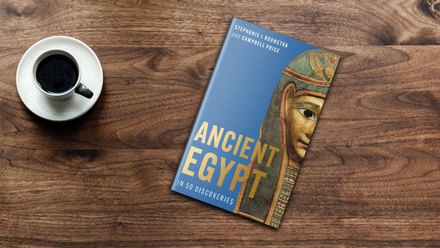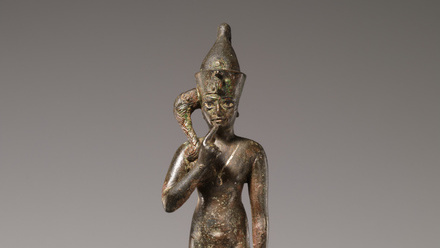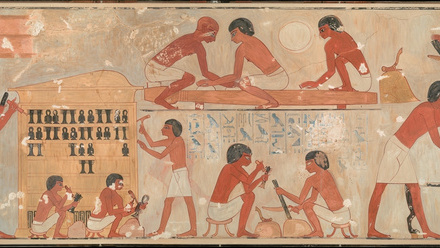Hatnub
Clearance of the Quarry P access ramp
Hatnub is the Ancient Egyptian name for a quarry region in the Eastern Desert, just under 20km south-east of the site of Amarna. They considered this area the source of the highest quality Egyptian alabaster (also known as calcite or travertine), and the region is rich in traces of ancient roads and other industrial structures. The ancient quarrymen also left in-situ texts giving information about their expeditions. Most of the remains date from the Old to Middle Kingdoms, though there is evidence for some activity as late as the Graeco-Roman Period.
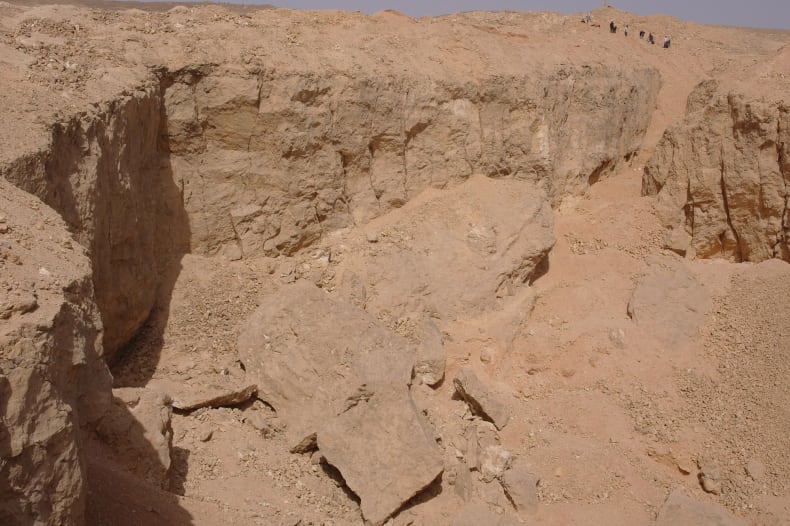
General view of interior of Hatnub Quarry P. The interior south wall of the quarry is the shaded area at left.
The first Egyptologists to visit Hatnub were Newberry and Carter in 1891, but the most recent work on the inscriptions (prior to our own) was undertaken by Möller in 1907. The broader archaeological landscape was surveyed by Petrie (1894) and Timme (1917), and more recently by Ian Shaw and his team (1986-1988, fully published by the EES in 2010). The EES funded work undertaken on and at Hatnub since 2016 forms part of the larger Hatnub Project (a joint Franco-British venture, co-directed by Yannis Gourdon and Roland Enmarch), which aims to fully record the Hatnub alabaster quarries’ surviving inscriptions, and also to better understand the broader industrial landscape in which the quarries sit.
Much of our work to date has focused on the largest open-cast working in the region, Quarry P, from which the largest number of texts survive. Our EES project had two initial goals: first to clear the interior south wall of Quarry P, where further unpublished texts were likely to be found under the current rubble level. The second part focused on recording unsurveyed archaeological features between Quarry P and the Nile valley using high resolution satellite imagery to precisely plan surviving remains and differential GPS survey to 'ground truth' and enhance those plans where the remains merit additional investigation.
Prior to the 2017 season, high resolution satellite imagery was used to remotely record the archaeological features within a 100km square study area between Hatnub and the Nile valley. During our fieldwork 810 000m2 of the ‘remote-survey’ area was covered by Dr. Hannah Pethen in a walkover survey, and the results recorded in the field with a GPS enabled tablet computer. A total of 512 discrete structures (such as huts, cairns, shrines) and 62 linear features (including paths, tracks, trails and the Quarry road) were surveyed. This ‘ground-truthing’ demonstrated that the remote-survey process was reliable and accurate with a 93% success rate in identifying archaeological features.
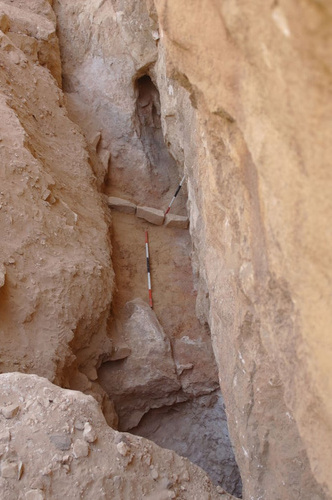
View along part of trench against inner south wall of Quarry P.
In 2017, we cleared the interior south wall of Quarry P, and recovered numerous fragments of detritus from Möller’s 1907 expedition to the site, including fragments of his epigraphic tracing paper. Five small rough stelae (and one rough stone basin) were recovered from the fill of the trench, three with text/image in red, and one carved and painted in red. In addition, we undertook further epigraphic investigation in the area of the access ramp to Quarry P, revealing a red-painted image of two seated men, with traces of a very badly damaged text. Dr. Hannah Pethen also recorded a number of the incised and relief texts using RTI.
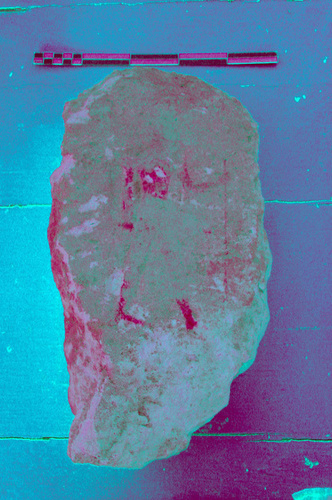
Newly discovered stela HP 5, found in south wall trench (natural light photo enhanced using D-stretch)
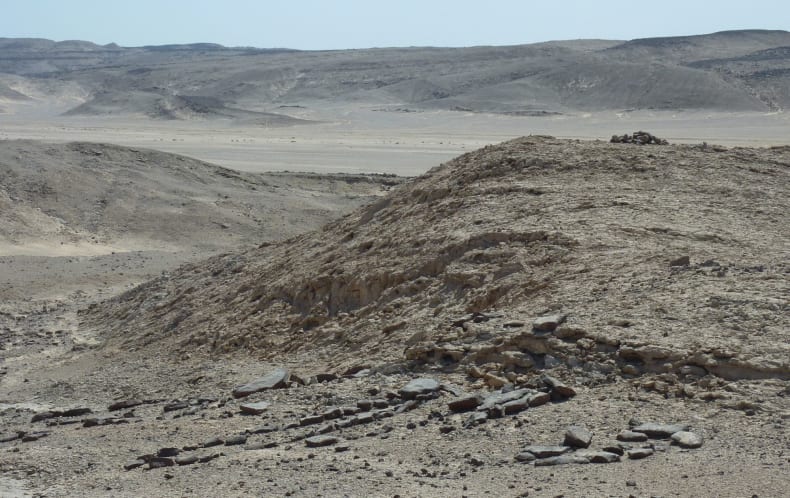
View of desert landscape around Hatnub quarry P, showing cairns and dry-stone ‘shrine’ features.
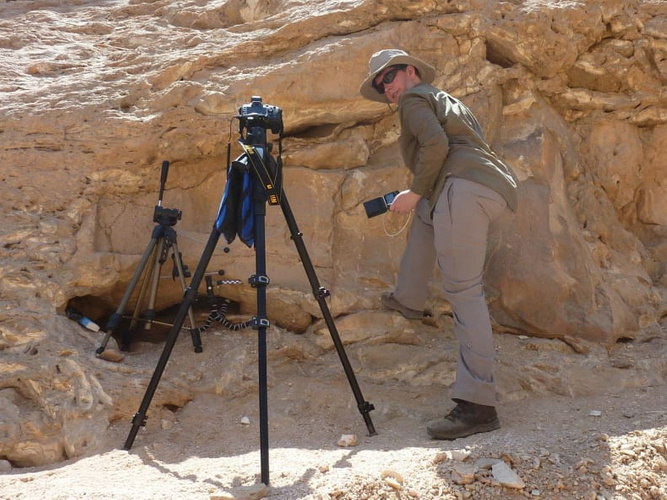
Hannah Pethen recording inscription Anthes XI zeta using RTI.
Work on the clearing the access ramp to Quarry P, in addition to revealing new texts, has also revealed a series of post-holes from the time of Khufu suggesting a basic pulley system was used for stone haulage. This is almost 2000 years earlier than the next oldest known pulleys, and offers potential insights into the construction of the Giza Pyramids. Next season (September 2019), we will continue clearing the access ramp of the debris that still partially encumbers it, in order to better understand the traces of the ancient stone haulage system. We hope to establish conclusively that the double staircase attested at present at opposite ends of the entryway in fact continues all the way along the entryway. By the same token, we hope to demonstrate that the post-hole pattern indicative of the pulley-based ancient stone haulage system also continues all the way along the entryway. This clearance is also likely reveal further previously unknown rock inscriptions, and perhaps further stone stelae.
Once this work is completed, we hope to be able to better characterise the pattern of activities undertaken by the quarrymen in this area of Quarry P. Given the restricted nature of space in the Quarry P access ramp area, we will also be better able to understand how the monumental commemorative activities relate to the immediate proximity of ancient stone haulage processes. It is now clear that the monumental rock-cut panels commemorating Khufu of the Fourth Dynasty would have been far overhead for the workmen hauling stone up besides them, though this is not the case for the Sixth Dynasty (and possibly later) memorials we have discovered more recently nearer to the bedrock.
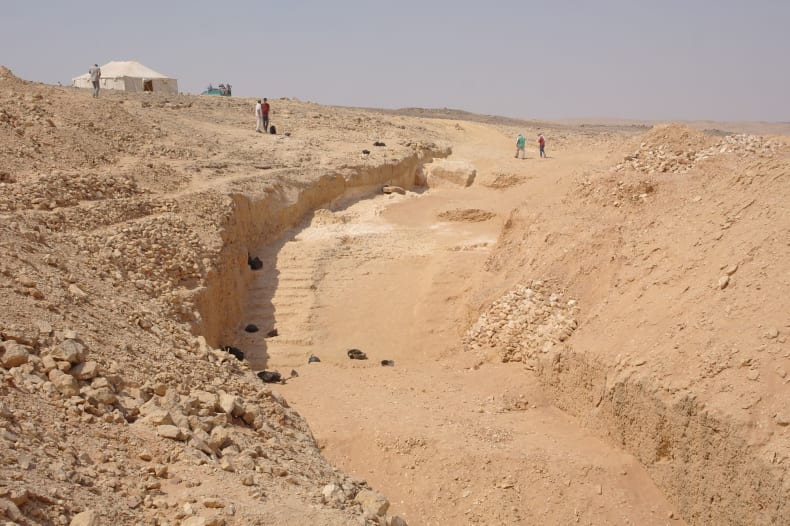
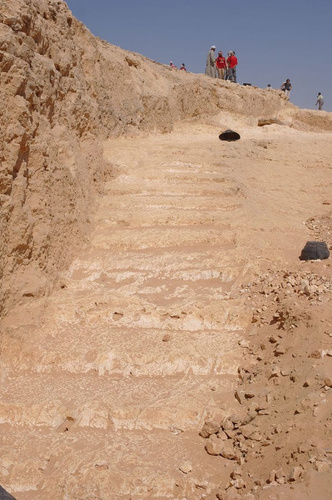
Two views of the upper area of the Quarry P access ramp, showing the rock-cut stairway
Thanks
The Hatnub team wishes to thank Mr. Mohammed Khallaf, director of the Middle Egypt at the office for antiquities in Miniah, represented by Mahmoud Salah, director of Miniah at the office for antiquities in Miniah, Mr. Hamada M. Abdel Moeen Kellawy, and Mr. Mohammed Khalil Mohammed Khalil, our MSA inspector for his support and his work during our mission in Hatnub.
Further reading
R. Enmarch and Y. Gourdon (2018), 'The Son of a Chief of Sculptors Djehutmose at Hatnub', Journal of Egyptian Archaeology 103.2.
Y. Gourdon and R. Enmarch (2016), ‘Some Unpublished Inscriptions from Quarry P at Hatnub’, in G. Rosati and M. C. Guidotti, Proceedings of the XI International Congress of Egyptologists (Florence: Egyptian Museum), 237-241.
R. Enmarch (2015), 'Writing in the "Mansion of Gold": Texts from the Hatnub Quarries', Egyptian Archaeology 47, 10-12
I. Shaw (2010). Hatnub: Quarrying Travertine in Ancient Egypt. Egypt Exploration Society, Excavation Memoir 88. London: Egypt Exploration Society.

